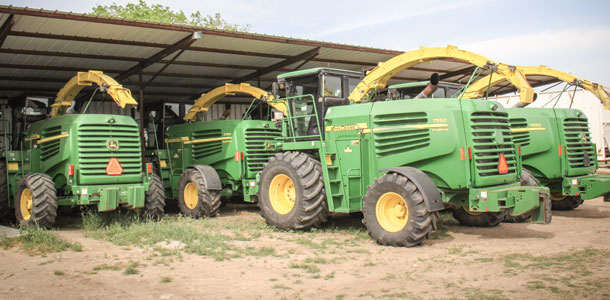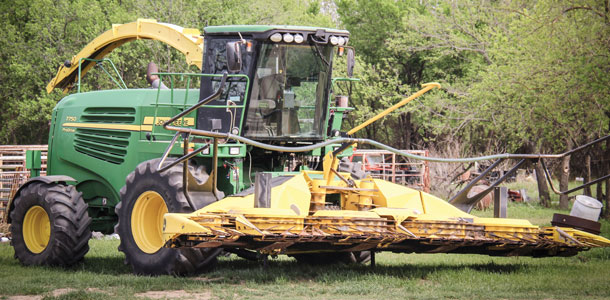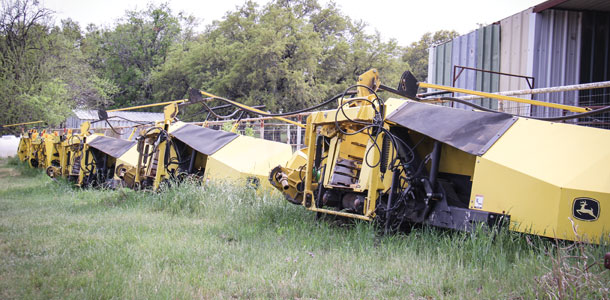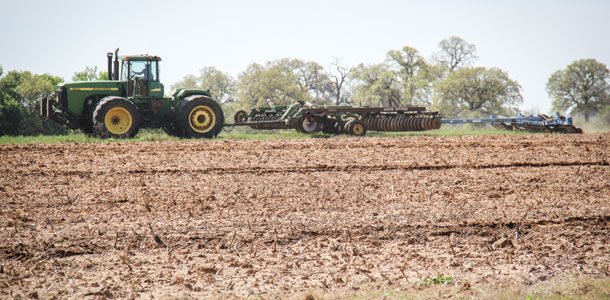Silage harvesting crews from the company travel all over Texas and surrounding states to harvest, or chop as they call it, approximately 400,000 tons of forage a year.
What started in 1994 as a husband and wife with one New Holland harvester and one bobtail truck has grown tremendously in the years since.

Owners Jay and Shayne Procter now boast six John Deere self-propelled forage harvesters, eight John Deere tractors and an Ag-Bag bagger. They own a semi-truck and lowboy trailer with which they haul 90 percent of their equipment from job to job.
As far as semi-trucks and trailers to haul the cut commodity, the company chooses to hire independent operators with their own rigs instead of purchasing a self-owned fleet.
Procter says, “Hiring trucks eliminates not only the cost of having to buy them myself but also the hassle of finding drivers and the stress of keeping them maintained and running when I have plenty of other equipment to keep running.”
All of this equipment and their wide range of travel together bring on one of their biggest challenges – labor. “Labor force is a big problem for us.
There’s not enough quality and experienced help willing to travel with us,” says Procter. With only six full-time employees, the company relies on hiring 10 to 15 seasonal employees during the harvest season.
This year, for the first time, Jay Procter Farms Inc. is looking into an international workers program, and they are hoping to have two or three workers from New Zealand for the 2014 season.
Labor, unfortunately, is not the biggest problem they face; it’s weather. Much like the rest of the agriculture industry, drought is a serious problem for silage harvesters.
Not only has production quality and quantity decreased in recent years, they have had customers unable to plant a crop of any kind due to lack of rain.
Though there are challenges on both the production and harvest sides of the industry, Procter says getting paid is usually not an issue. “We seldom have trouble because 95 percent of our customers are longtime customers.”
But just as those longtime customers try and take care of him, Procter does his best to take care of them as well.
“To do a good job and keep customers happy and coming back year after year is time-consuming and hard work with lots of problems you have to take care of, but it is very satisfying to do and know not everyone can do what you do,” Procter says.
When it comes to scheduling these customers and setting their rates, it takes much more than one might think. Crop stage and physical location are the two primary factors when it comes to scheduling.
“Crops down south plant and harvest earlier than crops up north, so that’s typically how we set our schedule up,” Procter says. Rates are set based on the company’s estimated business costs for the year, but the Procters also visit with other harvesters in the area in order to keep the industry competitive.
Though 500 miles is not their current travel limit, it is about the furthest they have gone so far. Sharon Springs, Kansas serves as their northernmost job, with Brownsville, Texas at the southern end.
The New Mexico state line typically serves as the limit of their western travel, and last year’s harvest expanded the business eastward all the way into central Mississippi. The Procter crew typically harvests silage for dairies and feedlots of varying size and scale.
Procter also plants approximately 650 acres of his own land in sorghum silage, which is either sold to surrounding dairies or packed into their personal pit and fed to the family’s beef cattle operation.
The plowing, planting and other production preparation for these crops is all done by employees with Procter’s equipment.
The company’s typical season runs from late March to the end of November and even into December at times. The spring harvest involves alfalfa, triticale and wheat, which are typically swathed down and then harvested via a pick-up head on the machine.

This method allows all six machines to harvest 800 to 1,000 acres of crop per day.
Summer and fall harvest typically includes corn and sorghum, which are harvested with a direct head. A quality corn crop can slow a machine down to harvesting 60 to 80 acres per machine per day, a situation the Procters will never complain about.
Procter explains that for his employees, pulling into a corn field where the plants are taller than the cab of the machine is always a season highlight.
On the other side, when looking to contract with a custom harvester, Procter has three suggestions. The first is to ask about equipment.
Find out the scale of the custom harvester’s operation by seeing how many harvesters, trucks and tractors they have and determining if they match the scale of the job you need done.
The second is to ask about experience. Ask how long they have been in the industry and get an idea of the jobs they typically do. His third piece of advice is to ask for references, noting that calling references is the “most important” of all.
With 20-plus years of commitment to the industry, Procter is more than satisfied where his business has taken him but says there are a couple of industry misconceptions he would like to clear up.
“One is that we are not trying to rush a customer into doing things they don’t want to do,” he explains. According to Procter, his crews are there to serve the customer and give them what they want, not the other way around.
The second misconception he addresses is one faced by many in the agriculture industry – professionalism. “We are highly skilled professionals, not just people who [due to lack of intelligence] can’t do anything else,” Procter says.
At the end of every day, Procter is most thankful for the experiences working in the industry has brought him and friends he’s made along the way.
“One of the nicest things about this industry is meeting people and making new friends, and most of the time they are at their very best and it is very rewarding.”
Whether or not the future includes the purchase of any additional harvesters, that 500-mile journey will definitely continue. When asked about his goals for the future of the business, Procter’s response was simple: “To continue to make a living, enjoy what I do every day and pass things on to my children if they want to continue on.” FG
PHOTOS
PHOTO 1: Jay Procter of Lingleville, Texas cites labor availability and inclement weather as the two biggest obstacles for custom harvesters.
PHOTO 2: A Texas-based “one harvester and a bobtail truck” custom harvester has grown his operation to include six self-propelled forage harvesters.
PHOTO 3: Silage chopper
PHOTO 4: Balers. Photo courtesy of Laura Procter.
Laura Procter
Graduate Assistant
Agricultural and Consumer Sciences
Tarleton State University









